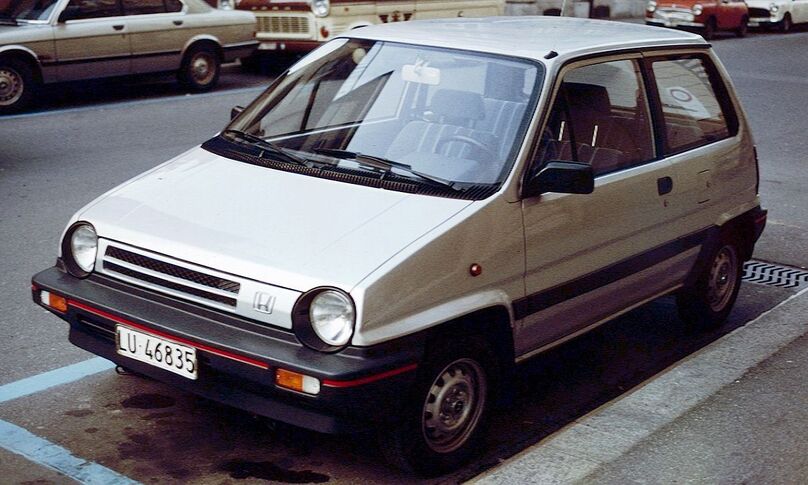
The first generation Honda City (Honda Jazz in Europe) was a subcompact hatchback aimed mainly at the Japanese domestic market. The somewhat ungainly designed City, referred to by Honda as "Tall Boy" style, was also marketed abroad and was available in a number of versions. First introduced in November 1981 it carried the model codes AA for sedans, VF for vans, and FA for the widetrack Turbo II and Cabriolets. It was sold at the Honda Japan dealership sales channel called Honda Clio.
History[]
While the City's layout was traditional for its category, with front-wheel drive and a transversely mounted engine, the innovative tall seating arrangement created comparable legroom to a car many times its size. This, combined with class leading fuel economy led to it being a rapid and considerable success in the Japanese domestic market. In spite of the creativity and novelty of its design, the City was narrowly pipped for the Japanese motoring journalists' Car Of The Year Award by the luxurious Toyota Soarer. The engine was the CVCC-II 1,231 cc four-cylinder "ER", specifically designed for the City. It was also available together with the Motocompo, a special 50 cc 'foldaway' scooter constructed to fit in the City's small luggage area, itself designed around the Motocompo. Originally a sportier R version, the economical E and two commercial van versions ("Pro") were introduced. In September 1982 a turbocharged version of the Honda ER engine was added to the lineup.
Designed by Pininfarina and introduced in August 1984, a drop-top Cabriolet utilized the wider track, fenders, and bigger bumpers of the Turbo II "Bulldog", but was only normally available with the naturally aspirated 67 PS (49 kW) engine. These widetrack models were designated "FA" rather than "AA". The Cabriolet was well equipped, with a glass rear window and twelve pastel colors not available on the hatchback versions. Part of a worldwide eighties' wave of convertibles based on family cars, this was the first car of this kind built in Japan.
A March 1985 light facelift brought a new asymmetrical grille (although not for the Cabriolet) and some interior improvements. The E and E II models were replaced by the new E III, while a lower priced U model joined the lineup. The U was the only non-commercial City to be available with a four-speed manual in the Japanese domestic market. Naturally aspirated engines in the AA Citys also gained a new fiber-reinforced aluminum alloy connecting rods ("FRM"), a world first in series production. One month later, the R became available with the interesting Hypershift transmission, a four-speed with an electronically controlled overdrive on second, third, and fourth gears - in essence creating a 7-speed gearbox.
In addition to vans and convertibles, there was also an "R Manhattan Roof" version with a 10 cm taller roof. A "R Manhattan Sound" version incorporated high-quality stereo equipment (including the "Bodysonic", transmitting sound vibrations through the seat). The E-series (E, E 1, E II & EIII; "E" for economy) used higher geared transmissions and trip computers to increase gas mileage. The E III, in addition to benefitting from the FRM conrods, also had an electronically variable lean-burn engine. First generation production ended in late 1986 with the introduction of the GA type City.
City Pro (VF)[]
Commercial versions were called Pro in Japan, and were available with either two or five seats (Pro T/F). The Pro had to make do without brake boost (until the 1985 facelift) and transistorized ignition (lowering power by two horsepower), and were also not available with the five speed manual transmission. The bare-bones Pro also had a manual choke.
Exports[]
Exports of the City were only of naturally aspirated hatchback and van versions. In Europe it was renamed Honda Jazz, due to Opel having the rights to the City name after having used it on a hatchback version of the Kadett C. It was marketed in Europe from 1982 to 1986, but was generally priced too high to compete. The European Jazz was only classified as a four-seater, and offered either 45 or 56 hp depending on fuel grade. The City was also sold in Australia (in two seater 'van' form, to circumvent Australian import restrictions on passenger vehicles at the time) and New Zealand (where it was locally assembled).
